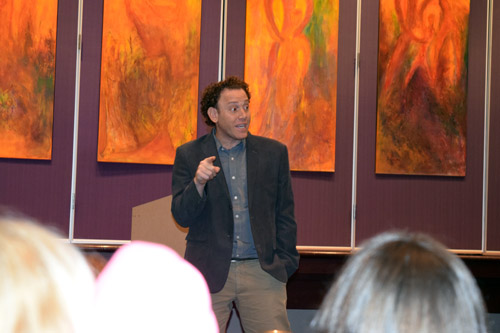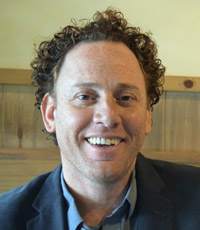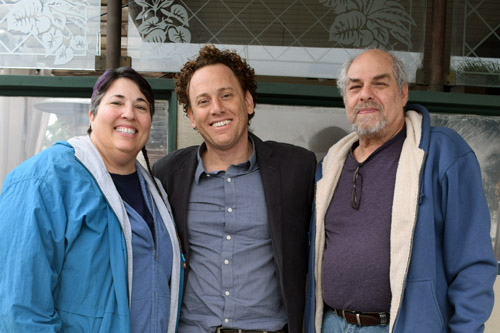
By Donald H. Harrison


SAN DIEGO – Those who believe that continuing wars with Arabs and a series of disgraced Israeli politicians have snuffed out Israeli idealism haven’t yet visited Hannaton, a kibbutz in the Galilee whose leaders believe that, by example, they can help to build a multi-cultural, egalitarian, Jewish society living in friendship with Arab neighbors.
Rabbi Yoav Ende, who directs the educational center at Hannaton, which is located approximately half way between Haifa and Tiberius, recently was a scholar in residence at Tifereth Israel Synagogue in San Diego, where a cousin of his wife’s, Giela Gray, is an active member.
Growing up, Ende had to look no farther than his parents to find role models. Both had made Aliyah, his father from Brooklyn, where he had been active in the student Zionist movement, and his mother from Baghdad. Their marriage, of an Ashkenazic male and a Sephardic female, meant that Ende grew up knowing two cultures, and along the way, he imbibed the generosity of spirit that motivated his mother to become a social worker and his father to become a teacher at the pluralistic Alexander Muss High School in Hod HaSharon.
The Alexander Muss High School is designed to give Jewish students from the various Jewish denominations overseas an experience of Israel and exposure to Jewish thought.
Ende went to a nearby public TALI school that included Jewish subjects in its curriculum. As a member of the Masorti (Conservative) Youth Movement he signed up for a Masorti unit within the Nahal, an IDF program in which members of a military unit works the land together, building or improving communities with strategic significance, before being assigned regular Army duties.
Ende’s Nahal unit, composed of Israelis from throughout the country, was sent to Hannaton, a Masorti kibbutz named for a place mentioned in Joshua 19:14. Describing the territory assigned by Joshua to Zebulon, that passage reads: “The border circled it, at the north of Hannaton, and its outlets were the Valley of Iphtah-el…” Although not on an international border like the communities served by many other Nahal units, Hannaton was considered strategically important because the Israeli government believed the Jewish presence needed to be reinforced in the Galilee, which is home to a substantial Arab population.
In the Nahal in 1993, at Hannaton, Ende renewed acquaintances with his future wife Shira, whom he earlier had met in the Conservative youth movement after she had made Aliyah from Boston. After fulfilling his military obligation, with service with the IDF in Lebanon, Ende traveled in South America for a half year, and then earned a bachelor’s degree in Middle Eastern Studies from the University of Haifa. He started a master’s program in Jewish studies there, but felt a restlessness in his soul. He decided he wanted to study Judaism in a “deeper way” than what the master’s program offered, and so he enrolled at the Schechter Institute of Jewish Studies in Jerusalem. After four years of study he become a Conservative rabbi in a land where the Conservative (or Masorti) movement was not recognized by Orthodox rabbinical authorities.

During the time of his rabbinical studies, Ende helped at a home for abandoned children in Kiryat Gat, which is situated between Tel Aviv and Beersheba. After he and Shira, who had become a social worker, were married in the United States, they decided that they would like to live in an “intentional community,” that is, a place where not only people lived together but where they shared a common purpose.
It should be a place where you “also do something for the society around it, with the intention of building a society,” Ende explained. “Doing what you think is right, doing work that would be beneficial, strengthening society, with Judaism in the middle of it.”
While there are some mixed secular and Orthodox communities in Israel, the young couple couldn’t immediately find what they were looking for “because the synagogue is our home, but we are not Orthodox. We wanted a place where the people could be religious and secular, but ‘religious’ is not only Orthodox.”
That led them back to Kibbutz Hannaton, which in the interim had seen its knitting mill go bankrupt and had only six families left on the kibbutz grounds. “People there saw the despair; we saw the potential,” Rabbi Ende said. “The synagogue was there, the mikvah was there, the educational center was there, the housing was there, run down and out of shape, but it was there, so we could dream of it.”
From six families, Hannaton has grown to 75 families, including Ende’s which includes four children, Tomer, almost 13; Elah, 11; Itai, 7; and Nadav, 3. The kibbutz is still growing with “interesting, diverse Israeli people from all walks of life—Conservative, Modern Orthodox, Reform, Secular. We are egalitarian, that is very important to us, and we are trying to create another model of religious life that is not (as in many other places in Israel) either Orthodox or secular.
“This is important not only for us, but for Israel, to have a range of identities, and not just a dichotomy,”
Ende said.
As executive director of the Educational Center, Rabbi Ende presides over a program that brings together young Israelis from throughout the nation to discuss such issues as “What is Judaism? What is Democracy? What comes before what? Can you do them together? What does religion mean? … What is the connection of Israel to the Jewish people (in Diaspora).”
Describing such issues as “existential questions,” Ende said that in the last five years, the Hannaton Educational Center has developed “a year course for Israelis, a leadership program, a gap-year program (between high school and service in the Army),” and has been upgrading the educational center’s facilities.
Besides Jewish students, the Hannaton Educational Center plans to reach out to Bedouin youth in the area who serve in the Israeli military. In addition, he said, the center reaches out to the neighboring Arab villages of Kfar Manda, Bir Maksur and Kfar Zarzir by sending to them teachers of English and Hebrew, as well as teachers for students with special needs. At the same time, he said, there are programs within Hannaton to teach Arabic to English and Hebrew speakers.
As opposed to the Arab-Jewish village of Neve Shalom near Latrun, said Ende, “our model isn’t living together, but living next to each other in our traditional societies, and being good neighbors, involved with each other.”
A majority of the students at Hannaton are Israelis. Students, who live in dormitories and eat together, are on special occasions invited to take meals with host families. Some students come from the United States or other English speaking countries, and they are matched with English speaking families who came to Israel via the Nefesh b’ Nefesh program, Ende said.
More information about the programs at Hannaton may be obtained via the educational center’s website at http://www.echannaton.org/facilities/kibbutz-hannaton/
*
Harrison is editor of San Diego Jewish World. He may be contacted via donald.harrison@sdjewishworld.com . Comments intended for publication in the space below must be accompanied by the letter writer’s first and last name and by his/ her city and state of residence (city and country for those outside the U.S.)
Pingback: School promotes peaceful encounters among Jews, Arabs - San Diego Jewish World